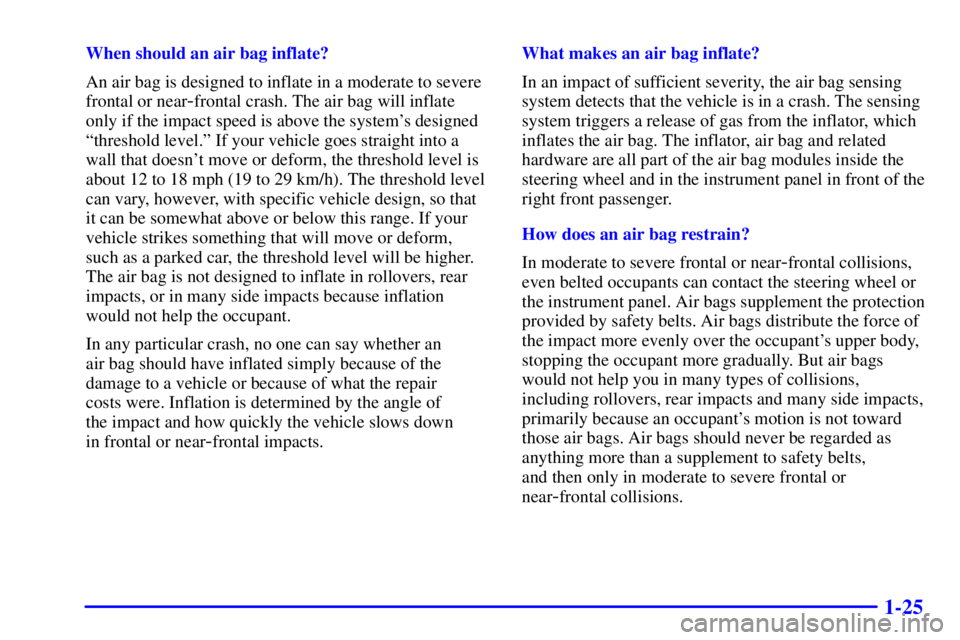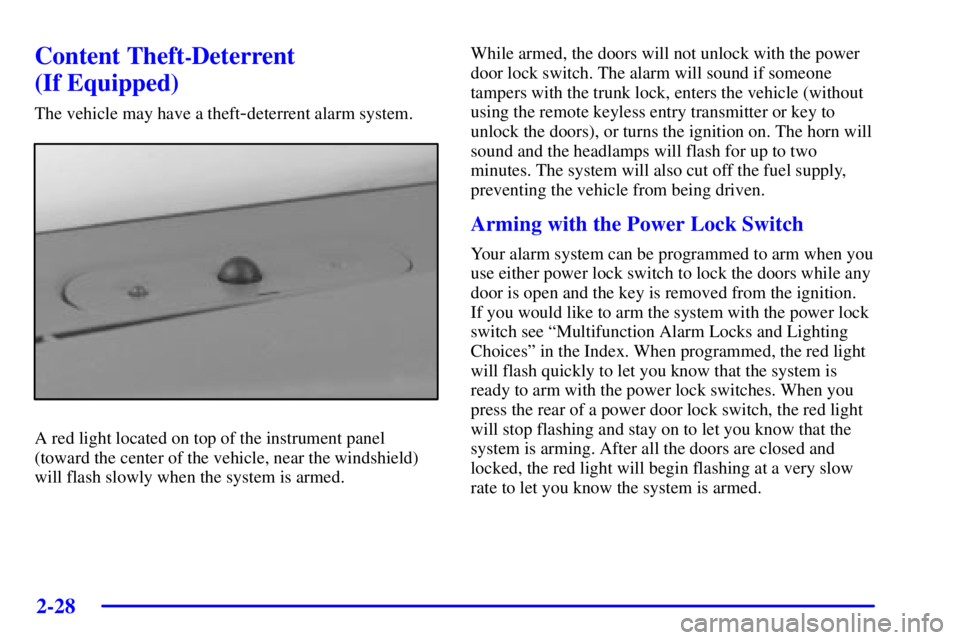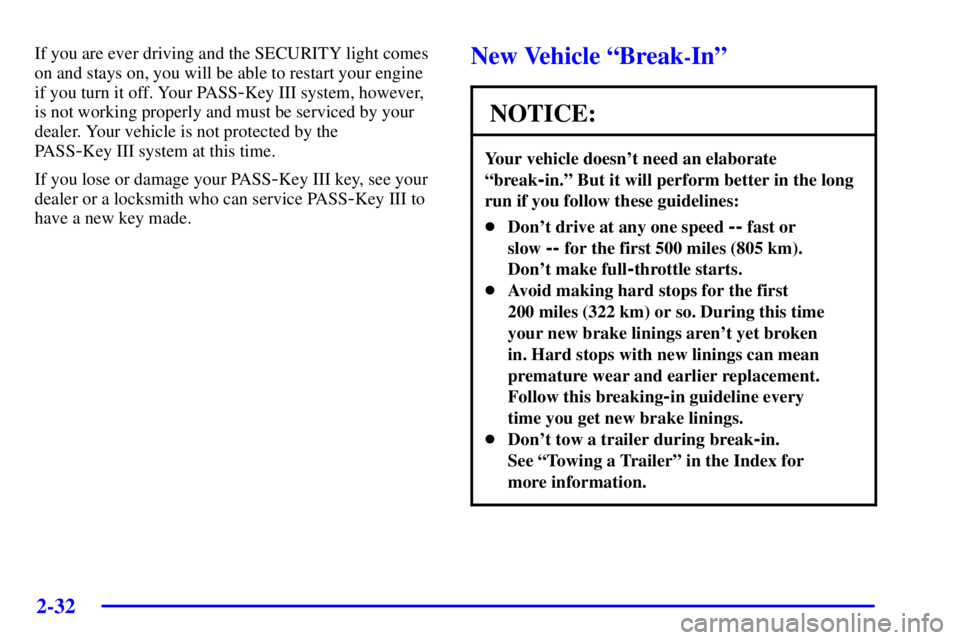Page 9 of 374
1-3 Six-Way Power Driver's Seat (If Equipped)
If your vehicle has this
feature, the control is
located on the outboard side
of the driver's seat cushion.
To adjust the seat cushion, do any of the following:
�Move the seat forward or rearward by sliding the
control toward the front or the rear.
�Raise or lower the seat cushion by sliding the control
up or down.
�Raise or lower the front portion of the seat cushion
by sliding the front of the control up or down.
�Raise or lower the rear portion of the seat cushion by
sliding the rear of the control up or down.
Four-Way Power Lumbar Driver's
Seat (Option)
If your vehicle has this option, there will be a control
located on the outboard side of the driver's seat cushion,
in front of the reclining seatback lever. To increase or
decrease lumbar support, push the control forward or
rearward. To adjust the lumbar support up or down, push
the control up or down.
Page 31 of 374

1-25
When should an air bag inflate?
An air bag is designed to inflate in a moderate to severe
frontal or near
-frontal crash. The air bag will inflate
only if the impact speed is above the system's designed
ªthreshold level.º If your vehicle goes straight into a
wall that doesn't move or deform, the threshold level is
about 12 to 18 mph (19 to 29 km/h). The threshold level
can vary, however, with specific vehicle design, so that
it can be somewhat above or below this range. If your
vehicle strikes something that will move or deform,
such as a parked car, the threshold level will be higher.
The air bag is not designed to inflate in rollovers, rear
impacts, or in many side impacts because inflation
would not help the occupant.
In any particular crash, no one can say whether an
air bag should have inflated simply because of the
damage to a vehicle or because of what the repair
costs were. Inflation is determined by the angle of
the impact and how quickly the vehicle slows down
in frontal or near
-frontal impacts.What makes an air bag inflate?
In an impact of sufficient severity, the air bag sensing
system detects that the vehicle is in a crash. The sensing
system triggers a release of gas from the inflator, which
inflates the air bag. The inflator, air bag and related
hardware are all part of the air bag modules inside the
steering wheel and in the instrument panel in front of the
right front passenger.
How does an air bag restrain?
In moderate to severe frontal or near
-frontal collisions,
even belted occupants can contact the steering wheel or
the instrument panel. Air bags supplement the protection
provided by safety belts. Air bags distribute the force of
the impact more evenly over the occupant's upper body,
stopping the occupant more gradually. But air bags
would not help you in many types of collisions,
including rollovers, rear impacts and many side impacts,
primarily because an occupant's motion is not toward
those air bags. Air bags should never be regarded as
anything more than a supplement to safety belts,
and then only in moderate to severe frontal or
near
-frontal collisions.
Page 45 of 374
1-39
Restraint Systems for Children
An infant car bed (A), a special bed made for use in a
motor vehicle, is an infant restraint system designed to
restrain or position a child on a continuous flat surface.
Make sure that the infant's head rests toward the center
of the vehicle.
A rear-facing infant seat (B) provides restraint with
the seating surface against the back of the infant.
The harness system holds the infant in place and, in a
crash, acts to keep the infant positioned in the restraint.
Page 58 of 374
1-52
CAUTION:
Never do this.
Here two children are wearing the same belt.
The belt can't properly spread the impact forces.
In a crash, the two children can be crushed
together and seriously injured. A belt must be
used by only one person at a time.
Q:What if a child is wearing a lap-shoulder belt,
but the child is so small that the shoulder belt is
very close to the child's face or neck?
A:Move the child toward the center of the vehicle,
but be sure that the shoulder belt still is on the
child's shoulder, so that in a crash the child's upper
body would have the restraint that belts provide. If
the child is sitting in a rear seat outside position,
see ªRear Safety Belt Comfort Guidesº in the
Index. If the child is so small that the shoulder belt
is still very close to the child's face or neck, you
might want to place the child in the center seat
position, the one that has only a lap belt.
Page 88 of 374

2-28
Content Theft-Deterrent
(If Equipped)
The vehicle may have a theft-deterrent alarm system.
A red light located on top of the instrument panel
(toward the center of the vehicle, near the windshield)
will flash slowly when the system is armed.While armed, the doors will not unlock with the power
door lock switch. The alarm will sound if someone
tampers with the trunk lock, enters the vehicle (without
using the remote keyless entry transmitter or key to
unlock the doors), or turns the ignition on. The horn will
sound and the headlamps will flash for up to two
minutes. The system will also cut off the fuel supply,
preventing the vehicle from being driven.
Arming with the Power Lock Switch
Your alarm system can be programmed to arm when you
use either power lock switch to lock the doors while any
door is open and the key is removed from the ignition.
If you would like to arm the system with the power lock
switch see ªMultifunction Alarm Locks and Lighting
Choicesº in the Index. When programmed, the red light
will flash quickly to let you know that the system is
ready to arm with the power lock switches. When you
press the rear of a power door lock switch, the red light
will stop flashing and stay on to let you know that the
system is arming. After all the doors are closed and
locked, the red light will begin flashing at a very slow
rate to let you know the system is armed.
Page 92 of 374

2-32
If you are ever driving and the SECURITY light comes
on and stays on, you will be able to restart your engine
if you turn it off. Your PASS
-Key III system, however,
is not working properly and must be serviced by your
dealer. Your vehicle is not protected by the
PASS
-Key III system at this time.
If you lose or damage your PASS
-Key III key, see your
dealer or a locksmith who can service PASS
-Key III to
have a new key made.
New Vehicle ªBreak-Inº
NOTICE:
Your vehicle doesn't need an elaborate
ªbreak
-in.º But it will perform better in the long
run if you follow these guidelines:
�Don't drive at any one speed -- fast or
slow
-- for the first 500 miles (805 km).
Don't make full
-throttle starts.
�Avoid making hard stops for the first
200 miles (322 km) or so. During this time
your new brake linings aren't yet broken
in. Hard stops with new linings can mean
premature wear and earlier replacement.
Follow this breaking
-in guideline every
time you get new brake linings.
�Don't tow a trailer during break
-in.
See ªTowing a Trailerº in the Index for
more information.
Page 93 of 374

2-33
NOTICE:
If your key seems stuck in LOCK and you can't
turn it, be sure you are using the correct key; if
so, is it all the way in? If it is, then turn the
steering wheel left and right while you turn the
key hard. Turn the key only with your hand.
Using a tool to force it could break the key or the
ignition switch. If none of this works, then your
vehicle needs service.
Ignition Positions
With the key in the ignition switch, you can turn it to
five different positions. The ignition switch is located on
the right side of the steering column.
A (ACCESSORY): This position lets you use things
like the radio and windshield wipers when the engine is
off. To use accessory, push in the key and turn it toward
you. The steering wheel will stay locked.
B (LOCK): This position locks the ignition, steering
wheel and transaxle. It's a theft
-deterrent feature.
It's also the only position from which you can remove
the key.
C (OFF): This position lets you turn off the engine but
still turn the steering wheel. It doesn't lock the steering
wheel like LOCK. Use off if you must have the vehicle
pushed or towed.
Page 100 of 374

2-40
There are several different positions for the shift lever.
PARK (P): This position locks the front wheels. It's the
best position to use when you start the engine because
the vehicle can't move easily.
CAUTION:
It is dangerous to get out of your vehicle if the
shift lever is not fully in PARK (P) with the
parking brake firmly set. Your vehicle can roll.
Don't leave your vehicle when the engine is
running unless you have to. If you have left the
engine running, the vehicle can move suddenly.
You or others could be injured. To be sure your
vehicle won't move, even when you're on fairly
level ground, always set your parking brake and
move the shift lever to PARK (P).
See ªShifting Into PARK (P)º in the Index.
If you're pulling a trailer, see ªTowing a Trailerº
in the Index.
Make sure the shift lever is fully in PARK (P) before
starting the engine. The vehicle has an automatic
transaxle shift lock control system. You must fully apply
the regular brakes and press the shift control button
located on the front of the shift lever, before you can
shift from PARK (P) when the ignition is in RUN. If you
cannot shift out of PARK (P), ease pressure on the shift
lever by pushing it all the way into PARK (P) while
keeping the brake pedal pushed down. Release the shift
lever button. Then move the shift lever out of PARK (P),
being sure to press the shift lever button. See ªShifting
Out of PARK (P)º in the Index.
REVERSE (R): Use this gear to back up.
NOTICE:
Shifting to REVERSE (R) while the vehicle is
moving forward could damage the transaxle.
Shift to REVERSE (R) only after the vehicle
is stopped.
To rock the vehicle back and forth to get out of snow,
ice or sand without damaging the transaxle, see ªStuck:
In Sand, Mud, Ice or Snowº in the Index.